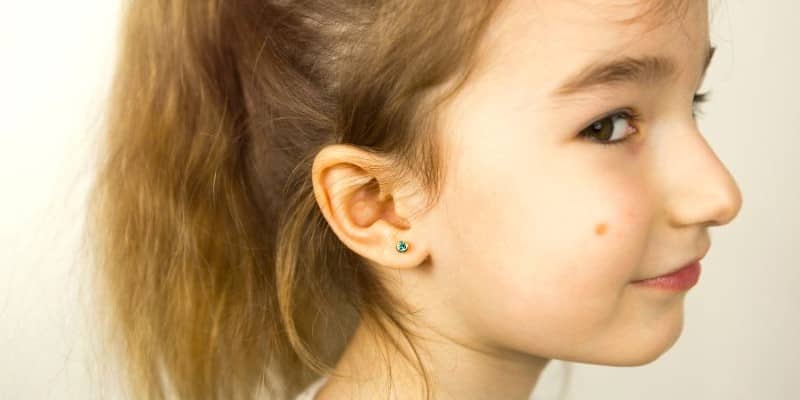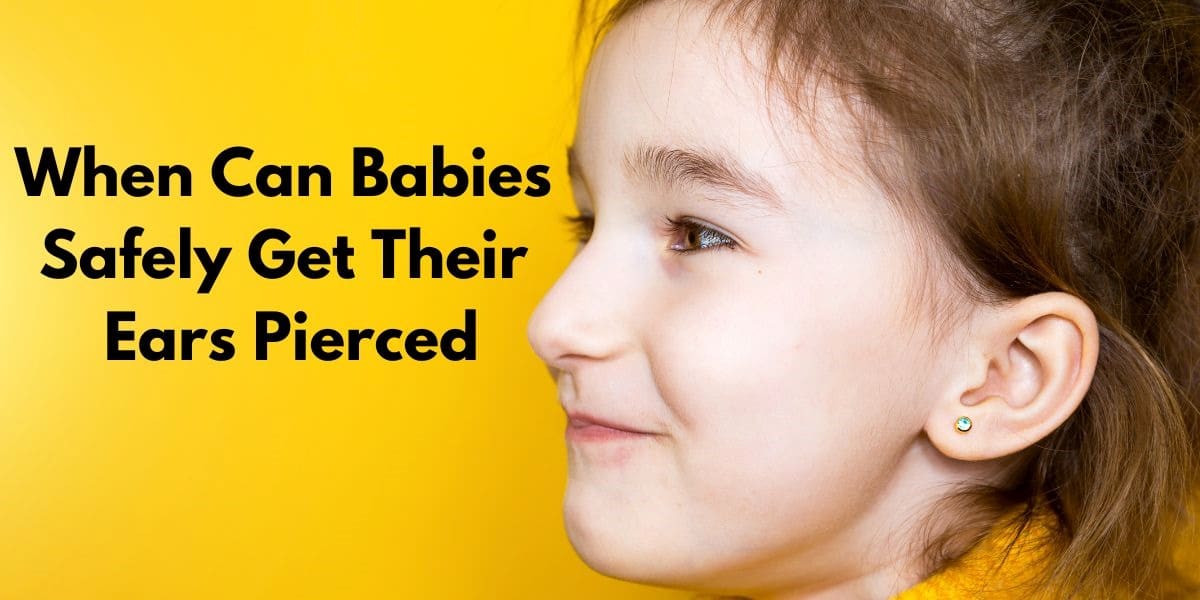Have you ever wondered when it is safe for babies to get their ears pierced? This article provides answers to that burning question and aims to give parents peace of mind when considering this cosmetic procedure for their little ones.
With expert opinions and scientific research, you will gain a better understanding of the right age and precautions to take before making this decision. Additionally, we will address frequently asked questions, such as the risks involved, the recommended age range, and the appropriate care for newly pierced ears.
Factors to Consider
Age of the baby
When considering whether to get your baby’s ears pierced, it’s important to take into account their age. Most pediatricians recommend waiting until your baby is at least six months old before getting their ears pierced. At this age, their immune system is more developed, and they are better able to handle the healing process.
Development of the baby’s immune system
A strong immune system is crucial for the healing process after getting ears pierced. Babies’ immune systems are still developing during their early months. Waiting until they are a bit older can help reduce the risk of infections and complications. It is important to ensure that your baby’s immune system is strong enough to handle the procedure and the healing process that follows.
Ability to properly care for the pierced ears
Before deciding to get your baby’s ears pierced, consider whether you have the time, patience, and ability to provide proper aftercare. This involves cleaning the ears regularly, avoiding irritants, and paying attention to any signs of infection or complications. If you are confident in your ability to care for your baby’s pierced ears, it may be the right time to proceed.
Risks and complications
It’s important to be aware of the potential risks and complications that come with ear piercing for babies. Infections, allergic reactions, and prolonged pain or redness are some of the possible complications. By considering the risks associated with the procedure, you can make an informed decision about whether or not it is the right choice for you and your baby.
Medical Recommendations
Consulting with pediatrician
Before making any decisions, it is highly recommended to consult with your pediatrician. They can assess your baby’s health condition and provide personalized advice regarding the best time and approach for getting your baby’s ears pierced. Your pediatrician’s guidance is crucial in ensuring your baby’s safety and comfort throughout the process.
Recommended minimum age
While there is no set rule for the minimum age at which babies can get their ears pierced, most pediatricians advise waiting until at least six months. By this age, the risk of complications is relatively lower, and the baby’s immune system is more developed. However, every baby is different, and your pediatrician’s recommendation may be influenced by your baby’s specific health condition.
Health condition assessment
Your pediatrician will assess your baby’s overall health condition, including any existing or past medical issues, before giving their recommendation. Babies with certain medical conditions or compromised immune systems may need to postpone ear piercing until they are older or stronger. The health and well-being of your baby should always be the primary consideration when making this decision.

Professional vs. Home Piercing
Professional piercing procedure
Having your baby’s ears pierced by a professional piercer ensures a higher level of safety and hygiene. Professional piercers follow strict protocols to minimize the risk of infections and complications. They have the knowledge and experience to perform the procedure efficiently and with minimal discomfort to your baby.
Sterile environment and tools
Professional piercing studios maintain a sterile environment to prevent the spread of infections. They use sterile piercing needles and jewelry, reducing the risk of contamination. The importance of sterile tools cannot be stressed enough, as it significantly lowers the chances of post-piercing complications.
Risk of infection with home piercing kits
While it may be tempting to use home piercing kits, they come with a higher risk of infection. These kits often lack the proper sterility protocols observed in professional studios. Additionally, the equipment provided may not be suitable for safe and comfortable piercing. It is best to avoid home piercing kits and opt for professional piercers who prioritize the health and safety of your baby.
Age-Related Considerations
Newborns
It is generally not recommended to pierce a newborn’s ears. Newborns have fragile immune systems and are more susceptible to infections. Additionally, their earlobes are soft and delicate, making it harder for the piercing to heal properly. It is advisable to wait until your baby is older, and their immune system has developed before considering ear piercing.
Infants
Around the age of six months, infants’ immune systems are more developed, making it a suitable time for ear piercing. However, proper aftercare is crucial, as infants may be more prone to complications. Consult with your pediatrician to determine if your infant is ready for ear piercing and to receive guidance on caring for their newly pierced ears.
Toddlers
For toddlers, ear piercing can be a reasonable option. By this stage, their immune system is even stronger, and they may have a better understanding of personal care and hygiene. However, it is still recommended to consult with your pediatrician and choose a professional piercer who can provide a safe and comfortable experience for your toddler.
Ear Care and Maintenance
Cleaning methods
To maintain the hygiene of your baby’s newly pierced ears, clean them regularly with a saline solution or an antiseptic solution recommended by your pediatrician or piercer. Use a cotton ball or pad to gently clean around the earrings, ensuring that you do not rotate or move the earrings excessively. Follow the cleaning instructions provided by your piercer or pediatrician.
Avoiding irritation
To minimize the risk of irritation, avoid exposing your baby’s ears to irritants such as harsh chemicals, hair products, or perfumes. Try to keep long hair away from the earrings to prevent tangling or pulling. Opt for soft fabrics when dressing your baby to avoid friction against the ears, which can lead to discomfort and irritation.
Reducing the risk of infection
In addition to regular cleaning, there are several steps you can take to reduce the risk of infection. Avoid touching your baby’s earrings with dirty hands, and encourage others to do the same. Be cautious when changing your baby’s clothes or bedding to prevent snagging the earrings. If you notice any signs of infection, such as excessive swelling, discharge, or fever, contact your pediatrician immediately.
Also Check: When Do Babies Start Sleeping From 7 PM To 7 AM?
Choosing the Right Earrings
Material considerations
When choosing earrings for your baby, opt for materials that are hypoallergenic and non-irritating. Surgical stainless steel, titanium, and 24-karat gold are popular choices as they are less likely to cause allergic reactions. Stay away from earrings made of nickel or other cheap metals that may trigger allergies or irritate your baby’s sensitive skin.
Hypoallergenic options
Hypoallergenic earrings are specifically designed to minimize the risk of allergic reactions. Look for earrings that are labeled as hypoallergenic and have been tested for sensitive skin. Additionally, consider choosing earrings with smooth, seamless designs, as these can help reduce the risk of irritation and discomfort.
Proper sizing
Ensure that the earrings you choose are an appropriate size for your baby’s earlobes. Small, lightweight earrings are recommended for babies to ensure comfort and minimize the risk of pulling or snagging. Avoid earrings with large backings or dangles that may pose a choking hazard. If in doubt, consult with your piercer or jewelry professional to ensure the earrings are properly sized for your baby.
Signs of Complications
Infection
Signs of infection in a pierced ear may include redness, swelling, warmth, discharge, and increased pain or tenderness. If you notice any of these signs, contact your pediatrician immediately. Prompt treatment is essential to prevent the infection from spreading or causing further complications.
Allergic reactions
Allergic reactions can manifest as redness, itching, rash, or inflammation around the pierced area. If you suspect your baby is having an allergic reaction to the earrings, remove them immediately and consult with your pediatrician. They can recommend appropriate treatment or suggest alternative hypoallergenic earrings.
Prolonged pain or redness
While some discomfort or redness is normal during the initial healing period, prolonged pain or redness may be indicative of a problem. If your baby experiences prolonged or worsening pain or redness, consult with your pediatrician or piercer for further evaluation. It is important to address any concerns promptly to ensure the well-being of your baby.

Source: TheTechBrain AI
Aftercare Instructions
Following the piercer’s recommendations
After piercing your baby’s ears, the piercer will provide you with specific aftercare instructions. It is important to follow these instructions carefully to promote proper healing and reduce the risk of complications. The recommendations may include cleaning routines, avoidance of certain activities or substances, and information on when to return for a follow-up visit.
Regular cleaning regimen
Maintaining a regular cleaning regimen is vital for the health of your baby’s newly pierced ears. Clean the ears as instructed by your piercer or pediatrician, using a gentle saline solution or antiseptic provided. Avoid using alcohol, hydrogen peroxide, or harsh soaps, as they can be too drying or irritating for the delicate skin.
Avoiding swimming or submerging ears
In the initial healing period, it is advisable to avoid swimming or submerging your baby’s ears in water. Pools, lakes, and even bathtubs can harbor bacteria that may increase the risk of infection. Consult with your piercer or pediatrician about when it is safe for your baby to resume normal water activities.
Frequently Asked Question (FAQs)
Q: What is the recommended age to get a baby’s ears pierced?
Most pediatricians advise waiting until your baby is at least six months old before piercing their ears. By this age, their immune system is more developed, reducing the risk of complications. However, every baby is different, so it is essential to consult with your pediatrician for personalized advice.
Q: Can I pierce my baby’s ears at home?
While it may be tempting, it is not recommended to pierce your baby’s ears at home. Home piercing kits often lack the necessary sterility and safety measures provided by professional piercers. The risk of infection and complications is higher when not performed by a trained professional in a sterile environment.
Q: How can I tell if there is an infection or complication?
Signs of infection or complication include redness, swelling, warmth, discharge, prolonged pain, or worsening symptoms. If you notice any of these signs or have concerns about your baby’s pierced ears, reach out to your pediatrician or piercer for further evaluation and guidance. Prompt attention and treatment can prevent further complications.
